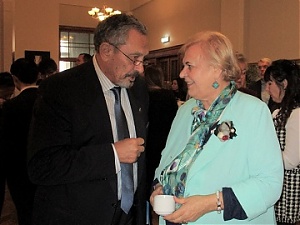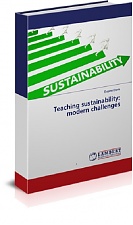Analytics, Book review, Economics
International Internet Magazine. Baltic States news & analytics
Sunday, 11.01.2026, 08:11
Teaching sustainability: changes in modern education policies
 Print version
Print version |
|---|
After the sustainability
issues have occupied a permanent place in the states’ political economies, another
problem occurred: i.e. implementation of SDGs and an optimal use of time in the
necessary transitional periods. Important part of the latter is the process of
“introducing” the SDGs into peoples’ minds and experiences. Thus, the issue of
teaching sustainability came into the education policies’ agenda. The author has
presented a first in Europe (and probably, in the world) introduction into the
complexities of such teaching with new approaches to
SDGs-learning, which are no longer an option but a must. *)
*) Eteris E. Teaching sustainability: modern challenges.
– Lambert Acad. Publ., 2019, - 80 pp. The book can be order from:
https://www.amazon.de/s?k=Eugene+Eteris&i=english-books&ref=nb_sb_noss
SDGs challenges
Teaching
sustainability is challenging on numerous grounds: first, because of the novelty
essence of sustainability; second, because of its interdisciplinary nature of
the SDG problems: by, the teaching process requires both cross-sectoral and
holistic knowledge which is not presently taught in the universities.
In teaching sustainability, instructors are often facing the need to dwell into uncharted waters of other scientific fields - natural, technical and social. Hence, the ways to build sustainability’s qualification need interdisciplinary approach.
As soon as sustainable growth becomes a critically urgent concept in the
states’ governance theories, on the win-win situation shall be economically
feasible approaches and solutions. However, most of the educators/teachers are
still in the linear market economy practice, which do not allow for
revolutionary approaches to modern SDGs.
Thus, new forms of teaching and learning are
necessary in delivering on SDGs, that can help students dealing better
with complexity, ambiguity, uncertainty, with new values and moral dilemmas; in
line with the breaking the “business-as-usual” approach, it has to be
challenges the “education-as-usual” concept. And in this regard, the new
author’s book deserves an additional attention to all interested in the SDGs
phenomenon.
The SDGs in national political economy
 |
|---|
No doubt, SDGs teaching is a “journey together”, so-called
new “social contract”: to making living places healthy (in a modern meaning,
sustainable), growth perspectives only through circular and bio-economies,
political guidance only through global climate goals. However, this can be done
only using most advanced science, technology and innovation achievements, with
a view towards optimal welfare conditions for present and future generations.
It is obvious that present development sectors in most
states are not sustainable! Hence, each region, country and community has to
make their own SDG-strategies; though teaching SDGs shall have some common
denominators: e.g. in energy sector
-on renewable energy and energy efficiency, in transport sector – on non-polluting transportation means, in economics –on sustainable development
and circular economy, etc. with learning by good examples as of paramount
importance.
SDGs cannot be taught through classical lecturing; a
combination of modern technologies, new political-economy methods and
best-practice’s sharing is needed.
Educating for a sustainable future is a formidable
challenge. How can we better understand the complexity of the world around us?
How are the problems of our world interconnected, and what does that imply for
their solution? What kind of world do we want for the future, within the limits
of our Earth’s life support systems? How can we reconcile the requirements of
economy, society, and the environment?
Higher education is
able to resolve numerous national, regional and global issues, including
implementation of the UN Sustainable Development Goals. Some of the SDGs
issues, while having clear answers, don’t have efficient tools (mostly
financial) for implementation. Besides, the SDGs-17 are oriented towards all
states in the world, though in less-developed countries, which are dominant in
numbers, the priorities might be different from welfare states.
The SDGs in universities
Higher education has experienced during last decades dramatic
changes: higher education and research are to take more active role in the
SDGs’ perspective implementation. SDGs provided means and ways to draft concise
and credible approaches to their implementation with a view of using different
levels of education and training by using modern tools and techniques to reveal
necessary knowledge and required skills.
Knowledge based system shall include SDGs components and
system's thinking. Besides, the following aspects shall be considered: “teach
the teachers” about the SDGs requirements; develop new e-learning skills in
SDGs teaching; developing partnerships with other universities teaching SDGs;
providing coordination among national political, economic, business, cultural
and educational authorities to facilitate the states’ SDGs fulfillment
obligations under the UN Agenda 2030, as well as an exchange of positive practices.
Teaching sustainability has become a challenging issue since
the UN 2030 Agenda entered into force. The success of implementing SDGs
depends, first of all, at the ability at states’ education policies to
accommodate the SDGs and 169 targets within the modern educational challenges.
Teaching SDGs is partially divided among several education policies’ levels:
schools, colleagues, higher education institutions (general and special).
Teaching and training today’s youth means provide
contemporary skills to tomorrow’s policy- and economy- decision makers,
providing them with necessary basic knowledge on modern 4th
industrial revolution challenges with a critical approach as well as
system-thinking approaches to complex socio-economic problems.
Both existing education institutions and teaching methods
shall be re-assessed fundamentally: higher education institutions shall teach
the necessary skills for SDGs; the teaching methods shall be adapted to the
needed general and professional skills to practically implement SDGs and
targets in the transformed socio-economic policies. Long-term professional and
vocational education/training shall be available through people’s life span.
All national middle- and high- education institutions shall provide valuable
examples for teaching future decision-makers providing them with the necessary
skills.
The aim and means to implement SDGs are on the table waiting to be included into the national priorities; now it’s the states turn to set SDGs high in education policies, in teaching and training. The task is complicated; but that doesn’t make national decision-makers to be the idle reviewers: “teaching SDGs” is offering a mix of knowledge and skills for effectively implementing SDGs and the global sustainable targets of the UN-2030 Agenda.
Finally, it's a pity that the Lambert Publishing didn't allow the author to make a wider review of SDGs in universities and modern economies: otherwise the book could be used by a much larger audience.








 «The Baltic Course» Is Sold and Stays in Business!
«The Baltic Course» Is Sold and Stays in Business!

